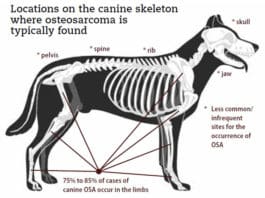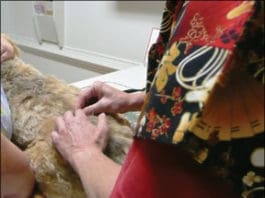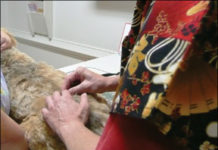New Hope for Treating Osteosarcoma On the Horizon
Many dogs do just fine after amputation necessitated by osteosarcoma. A new vaccine may help them continue to enjoy life even longer.
Canine Cancer Therapy Update
Despite everything modern medicine has to offer, cancer in dogs remains among the most feared of canine diseases. Just over a year ago, Whole Dog Journal reviewed conventional, complementary, and alternative cancer therapies in a series of articles. Since then, a cancer vaccine has been approved for veterinary use and a new version of an old herbal salve has become a “first choice” for many holistic veterinarians.
Acupuncture For Dogs With Cancer
without any hesitation
Canine Cancer Crisis
Cancer has to be the most feared diagnosis in all of medicine, one that sends patients and their families on a bewildering journey through statistics, treatment options, and life-or-death decisions that have to be made right now. Cancer has become so widespread that the care and treatment of its human patients is one of the world’s largest industries. Now cancer affects a significant percentage of veterinary patients as well.
Hemangioma in Dogs
The cause of hemangiomas is idiopathic (unknown). These growths usually don't appear until at least middle age. Thin-skinned, light-colored breeds often experience hemangiomas. You'll most likely find a hemangioma on the dog's trunk or legs, especially hairless areas like the lower abdomen.
About Mast Cell Tumors in Dogs
Mast cell tumors (MCTs) are the most common form of malignant skin cancer that occurs in dogs, accounting for about 14 to 21 percent...
Reduce Your Dog’s Cancer Risks
Veterinary oncologists say that cancers in humans and in dogs are incredibly similar, in terms of growth and prognosis. That's good news for both species, as research of human or canine cancer may yield insight about and new treatments for this deadly disease. In addition, many of the tactics that reduce the incidence of cancer in humans, veterinary oncologists say, can be used by pet owners to reduce the chances that their dogs will develop the disease. Here are four things you can do to help prevent cancer in your dog.
Liver Cancer in Dogs
True liver cancer tends to grow slowly, but your dog can be uncomfortable and feel sick. Many metastatic cancers that settle in the liver, such as hemangiosarcoma, have shorter survival times and may be painful. Keep in mind your dog’s quality of life.
Going Long
Summer is for reading, yes? These long summer days are a perfect time to relax and enjoy a good, long read that improves your...
Chemotherapy for Dogs: What to Expect
Cancer. My heart dropped to my stomach. In February 2010 my Border Collie Daisy became one of an estimated six million dogs diagnosed with cancer each year. Chemotherapy. My stomach tumbled to my feet. The diagnosis was scary enough; how could I possibly consider chemotherapy? I had visions of a treatment worse than the disease itself. As it turns out, my preconceptions of chemotherapy were far worse than its reality. Chemo hasn't cured my dog more on that later but it's given us more than 18 months (and counting) of joyful, quality time together.
Holistic Treatments for Osteosarcoma in Dogs
The date was Friday the 13th, so I guess I should have expected something unpleasant to happen, but the news from our family veterinarian that our 10-year-old Belgian Shepherd had, at the most about six months to live

















